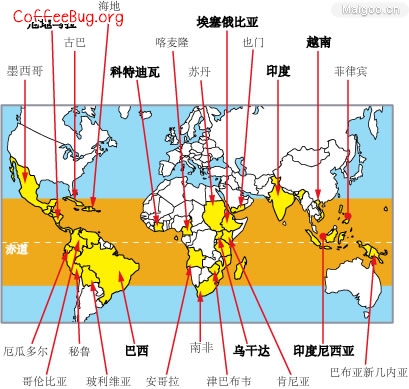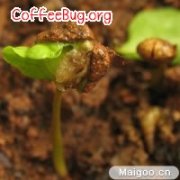Cultivation conditions of coffee "coffee belt" (Coffee Belt)
There is a noun called "Coffee Belt". There are more than 60 coffee producing countries in the world, most of which are located in the tropics and subtropics between the Tropic of Cancer (23 °26 'north and south). This coffee growing area is called a "coffee belt" or "coffee area" (Coffee Zone).

The annual average temperature of the coffee belt is above 20 ℃, because the coffee tree is a tropical plant and cannot grow normally if the temperature is below 20 ℃.
1. Climatic conditions
Arabica coffee is not resistant to high temperature and humid climate, nor can it stay at a low temperature below 5 ℃ for a long time, so it is planted on steep slopes of 1000 to 2000 meters above sea level. On the other hand, Robusta caffeine is adaptable (Robusta originally means "tenacious and strong") and is mostly grown in lowlands below 1000 meters above sea level.
The average annual rainfall of 1000 mm to 2000 mm, coupled with moderate sunshine, is the most suitable environment for coffee growth. However, Arabica coffee is not resistant to strong sunlight and extreme heat, so it is suitable for growing in terrain prone to morning fog, especially where there is a large temperature difference between day and night. In addition, some places will plant shelter trees in order to avoid direct sunlight, such as bananas, maize, mango trees and so on.

two。 Soil quality
To put it simply, the soil suitable for growing coffee is fertile volcanic soil with enough moisture and moisture, and rich in organic matter. The Ethiopian plateau is covered with this kind of volcanic weathered soil, so the soil rich in humus is naturally one of the basic conditions for growing coffee.
In fact, the main coffee-producing areas in the highlands of Brazil (called "Terra rossa", meaning fertile red soil weathered by basalt), the highlands of Central America, around the Andes of South America, the African highlands, the West Indies, Java (some of the soils are also weathered by volcanic rocks, or a mixture of volcanic ash and humus), and the Ethiopian highlands, have fertile soils with plenty of water.
Soil has a subtle effect on the taste of coffee. For example, the acidity of coffee grown on slightly acidic soil will also be strong; for example, the soil around Rio de Janeiro in Brazil has an iodine flavor, and the coffee will also be contaminated with that unique flavor by shaking the fruit to the ground when picking coffee beans.
3. Topography and height
It is generally believed that the coffee produced in the highlands is of better quality. Coffee-producing countries in Central America will use "elevation" as the grading standard because there are mountains crossing from the center of the continent. For example, SHB (Strictly Hard Bean) in Guatemala, the highest of the seven grades, is called SHB, which represents that its producing area is about 1370 meters above sea level.
Although the coffee farm is located on steep slopes and is not convenient for transportation, transportation, cultivation and management, this terrain has low temperatures and is prone to morning fog, which can ease the strong sunshine peculiar to the tropics and allow time for the coffee fruit to fully mature.
However, high-grade coffee such as "Blue Mountain" and "Hawaiian Kona" on the island of Jamaica are not harvested in the highlands. Because as long as there is the right temperature, rainfall and soil, there will be morning fog and a large temperature difference between day and night, high-quality coffee can be grown. It can be seen that even if "high real estate equals high quality", it does not mean that "low real estate equals low quality". Elevation can only be regarded as one of the reference criteria for judging the grade of coffee. Although elevation is important, the topography and climatic conditions of the producing area are more important.
European countries, the main consumer of coffee, gave high praise to highland coffee such as Kenya and Colombia a long time ago. Quantitative coffee beans can extract more coffee liquid (that is, higher concentration), which is one of the reasons why Highland Coffee is well received.
In addition, as mentioned earlier, Robusta coffee, which is native to the Congo, is grown in the lowlands below 1000 meters above sea level. Unlike Arabica, it grows fast and is resistant to diseases and insect pests, and can be grown in non-fertile soil. Therefore, the taste and aroma are far inferior to Arabica coffee.

Important Notice :
前街咖啡 FrontStreet Coffee has moved to new addredd:
FrontStreet Coffee Address: 315,Donghua East Road,GuangZhou
Tel:020 38364473
- Prev

How to make "follicular coffee hanging earbag" in order to drink the brewing method of hanging ear coffee?
The earbag of follicular coffee should be the integration of filter coffee at this stage. People who see this kind of earbag for the first time will think that it is a smart design. It puts the ground coffee powder into the inner filter bag, pulls open the movable ear next to it, hangs it on the edge of the coffee cup, and then brews it with hot water of about 85 degrees Celsius, which can easily filter out a cup with strong aroma.
- Next

In the process of coffee cultivation, coffee is grown with seeds with endocarp.
In the process of coffee cultivation, some people mistakenly think that coffee is grown directly with raw beans, but it takes a long time to grow but find that it does not sprout. In fact, coffee is grown with seeds with endocarp (Parchment). The inner fruit (or sheepskin or paper parchment) refers to the tea-brown hard skin that wraps the coffee seeds, and the coffee beans attached to that layer are called Parchment Bean. Dial
Related
- Detailed explanation of Jadeite planting Land in Panamanian Jadeite Manor introduction to the grading system of Jadeite competitive bidding, Red bid, Green bid and Rose Summer
- Story of Coffee planting in Brenka region of Costa Rica Stonehenge Manor anaerobic heavy honey treatment of flavor mouth
- What's on the barrel of Blue Mountain Coffee beans?
- Can American coffee also pull flowers? How to use hot American style to pull out a good-looking pattern?
- Can you make a cold extract with coffee beans? What is the right proportion for cold-extracted coffee formula?
- Indonesian PWN Gold Mandrine Coffee Origin Features Flavor How to Chong? Mandolin coffee is American.
- A brief introduction to the flavor characteristics of Brazilian yellow bourbon coffee beans
- What is the effect of different water quality on the flavor of cold-extracted coffee? What kind of water is best for brewing coffee?
- Why do you think of Rose Summer whenever you mention Panamanian coffee?
- Introduction to the characteristics of authentic blue mountain coffee bean producing areas? What is the CIB Coffee Authority in Jamaica?

